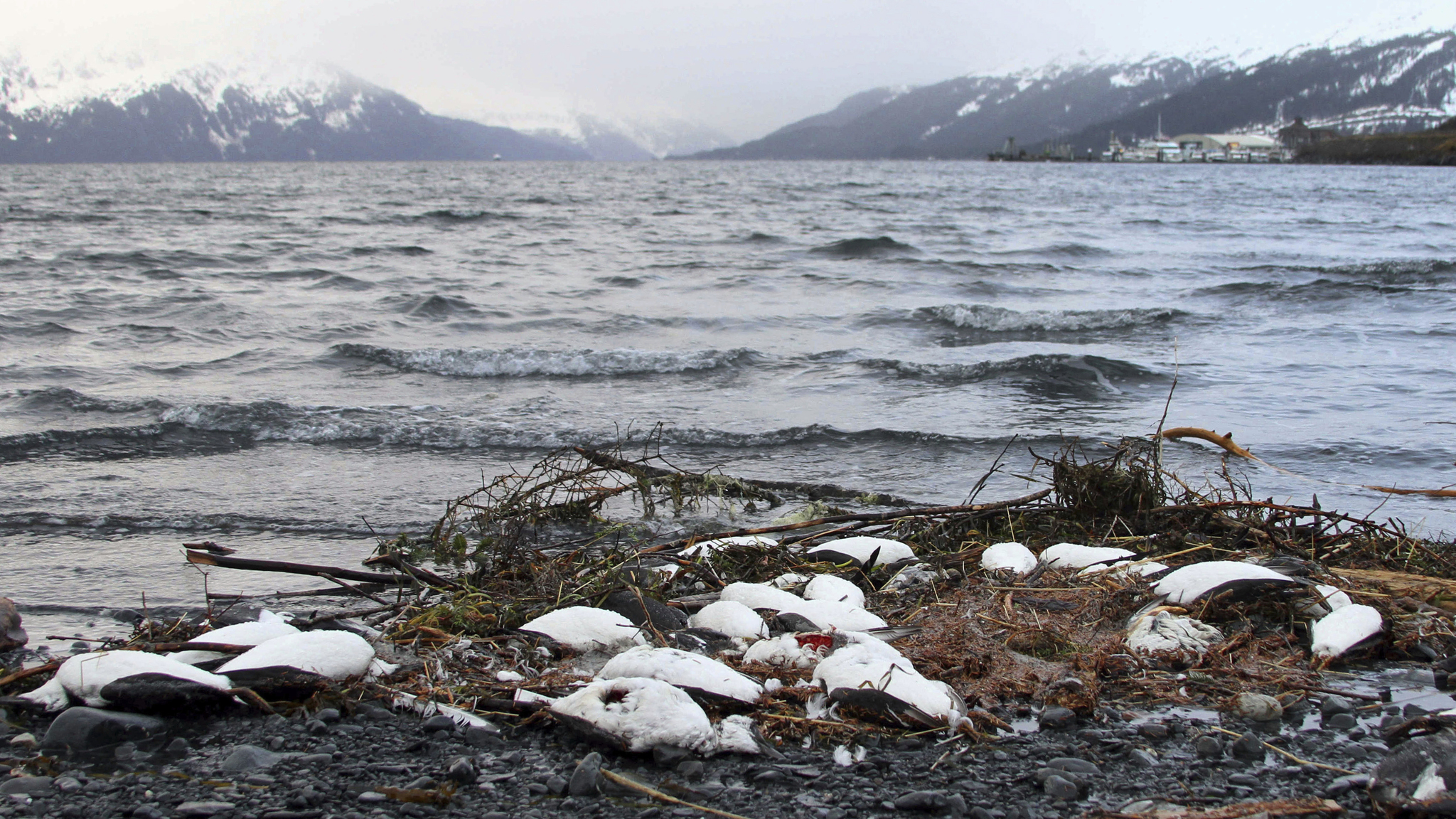ANCHORAGE — A year after tens of thousands of common murres, an abundant North Pacific seabird, starved and washed ashore on beaches from California to Alaska, researchers have pinned the cause to unusually warm ocean temperatures that affected the tiny fish they eat.
Elevated temperatures in seawater affected wildlife in a pair of major marine ecosystems along the West Coast and Canada, said John Piatt, a research wildlife biologist for the U.S. Geological Survey. Common murres are an indicator of the regions’ health.
“If tens of thousands of them are dying, it’s because there’s no fish out there, anywhere, over a very large area,” Piatt said.
To see such effect over two sizeable marine ecosystems is extraordinary, he said.
Deaths of common murres in Alaska likely were multiplied when starving birds in December 2015 were hit by vicious Gulf of Alaska winter storms, Piatt said.
Common murres look like thin penguins. They can fly miles in search of schools of finger-length fish and can dive and swim nearly 600 feet deep to capture them. However, the birds’ high metabolism means they have to eat a lot. If they don’t eat prey matching 10 to 30 percent of their body mass daily, they can use up fat reserves and drop to a critical threshold for starvation within three days.
Common murres eat small forage fish: capelin, from the smelt family, and juvenile pollock, which as adults are caught for fast-food fish sandwiches. Both fish were largely absent when the National Marine Fisheries Service conducted surveys in summer 2015.
Common murres paid the price. Volunteers and federal researchers last year counted the carcasses of 46,000 dead murres in Alaska and another 6,000 in California, Oregon and Washington.
Die-offs of seabirds occur periodically, but this one was spectacular. Only a fraction of the dead birds likely reached shore, Piatt said. And only a fraction of Alaska coastline was surveyed. A conservative extrapolation indicates 500,000 or more common murres died, Piatt said.
Nearly all were emaciated. As birds starved, they consumed their own fat and protein until they lost deadly amounts of body mass.
“You can’t keep yourself heated, and then you die,” Piatt said. “It’s an agonizing, awful death. And then on top of that, some of them probably drowned.”
Starting in 2014, the temperature in the upper 300 feet of water was as much as 4.5 degrees warmer than normal. NASA explained it like this: An unusually strong and persistent ridge of atmospheric high pressure appeared over the northeastern Pacific, weakening winds and easing normal, wind-driven churning, which promoted upwelling of deep, cold water to the surface. It led to a lens of unusually warm surface water that a University of Washington meteorologist dubbed “the Blob.”
Forage fish feed on zooplankton, and cold water produces the biggest, fattiest versions, said Shannon Atkinson, a physiologist and researcher at the University of Alaska Fairbanks.
“What that means is there’s not as much energy, and the energy that’s being transferred up the food web is not as energetically rich,” Atkinson said.
Warm ocean temperatures also affect big North Pacific fish such as halibut, cod, pollock and arrowtooth flounder, Piatt said. Their metabolism increases as the temperature increases, and they have to eat more.
“The dominant food for those fish is — get ready — juvenile pollock, capelin, sand lance,” Piatt said. “These fish are in direct competition with the birds now, and typically in most of these northern ecosystems, the large, predatory fish eat an order of magnitude more of those forage prey than the birds and mammals combined.”
The rates of carcass recovery by volunteers monitoring beaches in the Gulf of Alaska returned to normal levels in July 2016, Piatt said. However, common murres continued to have trouble finding food, and it showed up in breeding, he said.
Common murres lay eggs in approximately 230 Alaska cliff colonies. Heather Renner, supervisory wildlife biologist at the Alaska Maritime National Wildlife Refuge, monitors some of the largest.
“In 2016, we had widespread breeding failure at all of the colonies in the Gulf of Alaska, as well as the Bering Sea,” she said. “It was a highly unusual event. Murres don’t fail regularly.”
Breeding was normal at colonies in the Arctic and the Aleutians, she said.
There’s no question for Piatt that Pacific warmth was the ultimate cause of the common murre die-off.
“They died of starvation because there was no food,” Piatt said. “There was no food because there was no fish. And there was no fish because these warm waters did something to them.”

